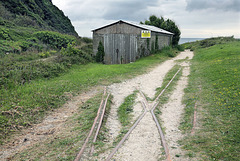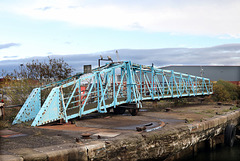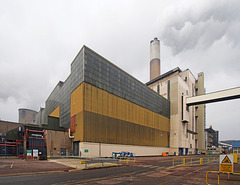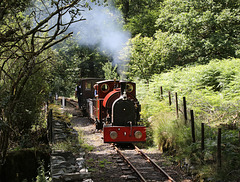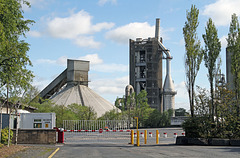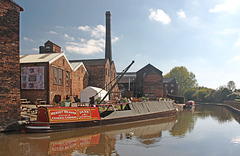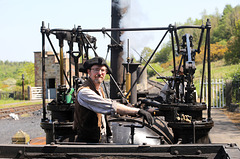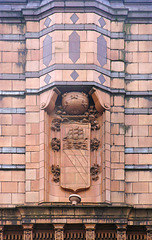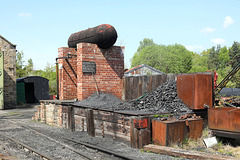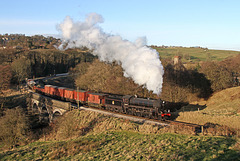tarboat's photos
Concrete blocks
| |
|
|
The 2ft 6in gauge Pentewan Railway brought china clay to the small harbour at Pentewan from 1830 until 1818 when the locomotives and track materials were requisitioned by the War Department. This was not the end or railways at Pentewan and W Lamb & Sons continued to operate a concrete block manufacturing works using sea sand obtained from the beach and head of the St Austell River at Pentewan. This business continued until 1966 when the Pentewan Dock & Concrete Co Ltd ceased operations. The block business used its own 2ft 6in gauge lines to carry sand to the works and employed diesel locomotives after 1930. The last operations used a Ruston & Hornsby diesel.
Today there are still remnants of track to be found at Pentewan, including this turnout and in the background is what I believe to have been the shed for the diesel locomotive.
Container cranes
| |
|
|
Opened in 1971, the Seaforth Dock site in the Port of Liverpool occupies about 500 acres, of which 85 acres is water. The dock was the largest built in the United Kingdom for some time, with 10,000 ft (3,000 m) of quay and a depth of 50 ft. A large part of the dock is dedicated to container traffic and these are four of the eight cranes used for containers.
Swinging
| |
|
|
Eastern half of the swinging footbridge over the channel between Gladstone and Alexandra docks, Liverpool. I suspect it hasn't been swung for quite a while.
The Salvation Army
| |
|
|
|
The rear of the Salvation Army building in Collingwood Street, Barrow-in-Furness. The building dates from 1910 and incorporates significant amounts of terracotta.
Llwynymaen Colliery
| |
|
|
Pen-y-llan No.5 shaft Llwynymaen Colliery in the Morda Coalfield. Mining in this area started well before the 1800. In 1798 there were at least 140 colliers at the Llwynymaen Colliery. In 1830 the concern was in the hands of Thomas Ireland & Co. and they operated the colliery until about 1840 when it flooded.
Temple Meads
Ratcliffe
Corris woods
Cement works
| |
|
|
Preheater tower and silo at the Hanson owned Ribblesdale Cement Works at Clitheroe. Dust collection to the fore and the chimney on top was at a funny angle after storm damage. The company was waiting for a shutdown when it would be reattached properly. The conical building on the left is a clinker store.
Transformed
RFA Fort Victoria
| |
|
|
|
RFA Fort Victoria is a Fort-class combined fleet stores ship and tanker of the Royal Fleet Auxiliary of the United Kingdom tasked with providing ammunition, fuel, food and other supplies to Royal Navy vessels around the world. The ship displaces 31,565 tons.
In this view the ship is in dock at Cammell Laird Shipbuilders at Brikenhead where it was undergoing a refit that included engine upgrades.
1904
| |
|
|
Terracotta plaques on a row of houses in Church Lane, Marple. It is little details such as these that are sadly lacking from modern buildings.
Middleport
| |
|
|
The Middleport Pottery opened in the 1880s and has continued in production to the present day. In 2009 with the business facing closure it was purchased by the Prince's Regeneration Trust and the buildings underwent restoration and regeneration. The boat is typical of those that carried pottery materials to the works and probably finished ware away for export.
The driver
| |
|
|
The Puffing Billy is said to be the oldest surviving steam locomotive in the world. It was constructed in 1813-1814 by colliery viewer William Hedley, enginewright Jonathan Forster and blacksmith Timothy Hackworth for Christopher Blackett, the owner of Wylam Colliery near Newcastle upon Tyne. It proved too heavy for the track and was rebuilt in 1815 with ten wheels, but was returned to its original condition in 1830 when the line was relaid with stronger rails. Puffing Billy remained in service until 1862, when Edward Blackett, the owner of Wylam Colliery, lent it to the Patent Office Museum in South Kensington, London (later the Science Museum). He later sold it to the museum for £200. It is still on display there. Its sister locomotive, Wylam Dilly, is preserved in the National Museum of Scotland in Edinburgh.
In 2006 a replica was built for use at Beamish Museum and it is this locomotive that is seen here operating on the Pockerley Waggonway on its first day back in service after a major overhaul and retubing over the winter. The driver seems happy with his steed and commented that the new boiler lagging was very effective and they were having trouble keeping the safety valves from lifting.
YMCA
| |
|
|
The YMCA, now St George's House, on Peter Street in Manchester was built 1906-11 to the design of architects Woodhouse Corbett, and Dean. The construction was by Gerrards of Salford. It was the first building in Manchester with a concrete frame which is clad in Burmantofts terracotta. The decoration includes this representation of the Manchester coat of arms. The building is listed Grade II.
Coal and water
Mytholmes
| |
|
|
As the sun begins to set B1 61264 takes its train across Mytholmes Viaduct during a 30724 Charters event.
Pride of Hull
| |
|
|
Seen at its berth on the Humber at Hull, the MS Pride of Hull is a Bahamas registered passenger and cargo roll-on/roll-off cruiseferry in service with P&O North Sea Ferries on the Hull - Rotterdam route. The ship was launched on 11 April 2001 and entered service on 2 December 2001. Upon entering service she was the joint title holder of the World's Largest Cruiseferry with her sister, the Pride of Rotterdam.

